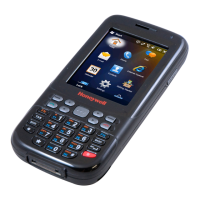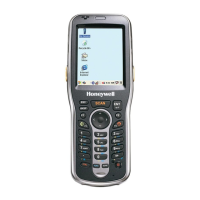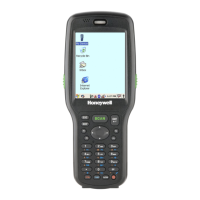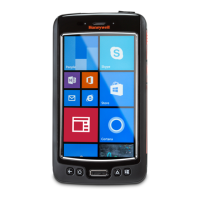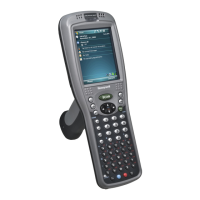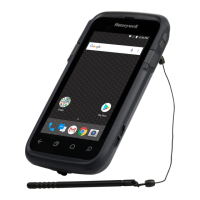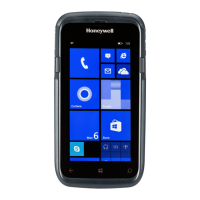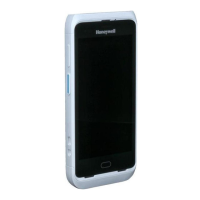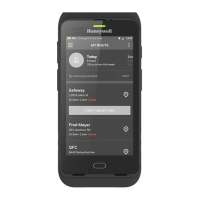Do you have a question about the Honeywell Dolphin 60s and is the answer not in the manual?
Describes the physical location of various labels on the Dolphin 60s terminal.
Identifies the location of device identification labels like model, serial, and IMEI numbers.
Details the safety classification and warnings related to the device's LEDs.
Lists safety standards compliance for UL and C-UL certifications.
Outlines regulatory compliance by region and relevant directives.
Details compliance with the R&TTE Directive for radio equipment.
Explains FCC rules and user precautions for radio frequency.
Outlines Industry Canada compliance and user warnings.
Explains radio frequency exposure limits and SAR compliance.
Details IC radiation compliance and minimum separation distance.
Details EU SAR compliance and ICNIRP guidelines.
Precautions regarding medical devices and RF emissions.
Details hearing aid compatibility ratings and usage advice.
Explains potential interference between microwaves and the terminal.
Lists items included in the terminal package.
Guides on initial setup steps for the Dolphin 60s.
Instructions for battery installation and initial charging.
Explains connecting and charging the terminal via USB.
Steps to boot the device and navigate the Home screen.
Describes the Home screen, Title Bar, icons, and scrolling.
Covers virtual keyboard usage, customization, and input methods.
Guides on accessing applications and managing files.
Explains file management during upgrades and using the search function.
Explains how to put the terminal into low-power suspend mode.
Step-by-step guide for battery replacement.
Details procedures for soft and hard system resets.
Lists standard hardware configurations for the device.
Describes optional accessories and peripherals for the terminal.
Details the components and functions of the terminal's front panel.
Details the components and functions of the terminal's back panel.
Explains the I/O connector pinout and primary battery.
Covers battery charging options, guidelines, and times.
Provides essential guidelines for battery pack safety and longevity.
Explains how to manage battery settings and error notifications.
Covers cleaning, maintenance, and SIM/memory card installation.
Details specifications for the bar code scanning engine, including field of view.
Lists all supported bar code types, categorized by symbology.
Explains how to decode bar codes using the terminal's scan demo.
Guides on taking and transferring images with the imager.
Instructions for taking pictures and recording video using the device's camera.
Overview of available keyboards and their common buttons.
Explains the usage of modifier and navigation keys for input.
Details key combinations for specific keyboards.
Introduces the main system settings menu and its icons.
Guides on setting system time, alarms, and password protection.
Explains how to personalize device buttons and owner information.
Details backlight control and battery status and power management.
Covers security certificates, file encryption, and error reporting.
Explains system info, SIP configuration, and managed applications.
Information on memory usage, power settings, and regional preferences.
Guides on uninstalling software and adjusting display properties.
How to monitor and manage running applications and processes.
Introduces the terminal's wireless communication options.
Guides for setting up network connections via modem.
Interface for managing and configuring wireless radios.
Configuration for PC connectivity and network adapters.
Procedures for data synchronization via ActiveSync or WMDC.
How to install new applications on the terminal.
Explains WWAN connectivity, necessary setup, and signal indicators.
Details voice and data performance over WWAN.
Steps to enable and configure WWAN radio for voice and data.
Guides on audio modes, volume control, and making calls.
Steps to configure data connections using Microsoft Connections.
How to manually select network carriers.
Steps to activate Bluetooth on the terminal.
Guides on establishing trusted connections with other devices.
Instructions for sending files wirelessly using Beam File.
How to make the terminal discoverable and receive incoming beams.
Information on the integrated GPS module and Assisted GPS support.
Details on accessing the GPS module via COM ports.
Description and setup of the HomeBase cradle.
Details on mobile charging accessories.
Procedures for charging terminal and spare batteries using the base.
Steps for setting up communication and connection.
Instructions for physically installing the HomeBase.
Information on how the mobile chargers provide power.
Steps to power the terminal and charge its battery with mobile chargers.
How to get help, find knowledge bases, and contact support.
Details the terms and duration of the product warranty.
Information on purchasing extended service plans.
Describes the physical location of various labels on the Dolphin 60s terminal.
Identifies the location of device identification labels like model, serial, and IMEI numbers.
Details the safety classification and warnings related to the device's LEDs.
Lists safety standards compliance for UL and C-UL certifications.
Outlines regulatory compliance by region and relevant directives.
Details compliance with the R&TTE Directive for radio equipment.
Explains FCC rules and user precautions for radio frequency.
Outlines Industry Canada compliance and user warnings.
Explains radio frequency exposure limits and SAR compliance.
Details IC radiation compliance and minimum separation distance.
Details EU SAR compliance and ICNIRP guidelines.
Precautions regarding medical devices and RF emissions.
Details hearing aid compatibility ratings and usage advice.
Explains potential interference between microwaves and the terminal.
Lists items included in the terminal package.
Guides on initial setup steps for the Dolphin 60s.
Instructions for battery installation and initial charging.
Explains connecting and charging the terminal via USB.
Steps to boot the device and navigate the Home screen.
Describes the Home screen, Title Bar, icons, and scrolling.
Covers virtual keyboard usage, customization, and input methods.
Guides on accessing applications and managing files.
Explains file management during upgrades and using the search function.
Explains how to put the terminal into low-power suspend mode.
Step-by-step guide for battery replacement.
Details procedures for soft and hard system resets.
Lists standard hardware configurations for the device.
Describes optional accessories and peripherals for the terminal.
Details the components and functions of the terminal's front panel.
Details the components and functions of the terminal's back panel.
Explains the I/O connector pinout and primary battery.
Covers battery charging options, guidelines, and times.
Provides essential guidelines for battery pack safety and longevity.
Explains how to manage battery settings and error notifications.
Covers cleaning, maintenance, and SIM/memory card installation.
Details specifications for the bar code scanning engine, including field of view.
Lists all supported bar code types, categorized by symbology.
Explains how to decode bar codes using the terminal's scan demo.
Guides on taking and transferring images with the imager.
Instructions for taking pictures and recording video using the device's camera.
Overview of available keyboards and their common buttons.
Explains the usage of modifier and navigation keys for input.
Details key combinations for specific keyboards.
Introduces the main system settings menu and its icons.
Guides on setting system time, alarms, and password protection.
Explains how to personalize device buttons and owner information.
Details backlight control and battery status and power management.
Covers security certificates, file encryption, and error reporting.
Explains system info, SIP configuration, and managed applications.
Information on memory usage, power settings, and regional preferences.
Guides on uninstalling software and adjusting display properties.
How to monitor and manage running applications and processes.
Introduces the terminal's wireless communication options.
Guides for setting up network connections via modem.
Interface for managing and configuring wireless radios.
Configuration for PC connectivity and network adapters.
Procedures for data synchronization via ActiveSync or WMDC.
How to install new applications on the terminal.
Explains WWAN connectivity, necessary setup, and signal indicators.
Details voice and data performance over WWAN.
Steps to enable and configure WWAN radio for voice and data.
Guides on audio modes, volume control, and making calls.
Steps to configure data connections using Microsoft Connections.
How to manually select network carriers.
Steps to activate Bluetooth on the terminal.
Guides on establishing trusted connections with other devices.
Instructions for sending files wirelessly using Beam File.
How to make the terminal discoverable and receive incoming beams.
Information on the integrated GPS module and Assisted GPS support.
Details on accessing the GPS module via COM ports.
Description and setup of the HomeBase cradle.
Details on mobile charging accessories.
Procedures for charging terminal and spare batteries using the base.
Steps for setting up communication and connection.
Instructions for physically installing the HomeBase.
Information on how the mobile chargers provide power.
Steps to power the terminal and charge its battery with mobile chargers.
How to get help, find knowledge bases, and contact support.
Details the terms and duration of the product warranty.
Information on purchasing extended service plans.
| Display diagonal | 2.8 \ |
|---|---|
| Display resolution | 240 x 320 pixels |
| Display number of colors | - |
| ROM capacity | 512 MB |
| Internal memory | 0.256 GB |
| Compatible memory cards | MicroSD (TransFlash), SDHC |
| Processor frequency | 0.8 GHz |
| Operating system installed | Windows Embedded Handheld 6.5 |
| Wi-Fi standards | 802.11b, 802.11g, Wi-Fi 4 (802.11n) |
| Bluetooth version | 2.1+EDR |
| Security algorithms | EAP-TLS, LEAP, MD5, PEAP, TKIP, WPA-PSK |
| Second camera | No |
| Rear camera resolution (numeric) | 5 MP |
| Headphone outputs | 1 |
| Headphone connectivity | 3.5 mm |
| USB 2.0 ports quantity | USB 2.0 ports have a data transmission speed of 480 Mbps, and are backwards compatible with USB 1.1 ports. You can connect all kinds of peripheral devices to them. |
| Storage temperature (T-T) | -20 - 60 °C |
| Operating temperature (T-T) | -10 - 50 °C |
| Operating relative humidity (H-H) | 5 - 95 % |
| Battery capacity | 3340 mAh |
| Product color | Black |
| Keyboard layout | QWERTY |
| Depth | 66 mm |
|---|---|
| Width | 136 mm |
| Height | 28.7 mm |
| Weight | 246.6 g |
